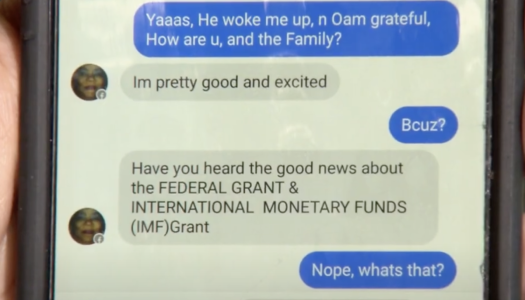Watch out for this "how are you" message—It could be a scam in disguise
By
Veronica E.
- Replies 0
A simple message from a familiar face might feel comforting—but these days, it could be the start of a scam.
Across the country, Americans are receiving “How are you doing today?” messages that appear to come from friends or family on social media or even by text.
What seems like a casual check-in can quickly spiral into a pitch for fake grants, giveaways, or miracle deals.
In reality, these friendly greetings are part of a growing impersonation scam that’s targeting millions.
If you or someone you know spends time on social media, here’s what you need to know to stay safe.

How the scam works
It often starts with a stolen profile.
Scammers hack into someone’s Facebook or Instagram account, then send messages to the person’s contacts—often with a friendly opener like “How are you doing today?”
Once they get a response, they shift the conversation toward a fake opportunity, such as a government grant, discounted product, or surprise giveaway.
These messages can seem convincing, especially when the scammer uses real names and profile photos.
But behind the scenes, it’s a trap designed to steal your money or personal information.
Also read: Could your next hotel reservation be at risk? What travelers need to know about this growing scam
Step-by-step: What the scammers do
Also read: That letter about missing money might not be a scam—here’s what to know
Real people, real losses
Jim, a retired tech worker, was contacted by a Facebook friend about a $150,000 “grant” from an organization called Global Empowerment.
The scammer sent him photos of a FedEx box filled with cash and asked for a $2,500 fee to claim it.
When Jim hesitated, the messages—and the supposed friend—disappeared.
Lesa Lowery was tricked into clicking a fake Facebook security email.
After entering her login info, she was locked out of her account and left without access to years of private messages.
Also read: A warning text led to this costly mistake—how one couple lost over $80K in a shocking scam
Why this scam is so effective
New tools make scams easier to pull off
Today’s scammers aren’t just persuasive—they’re well-equipped.
Some use phishing kits like “RaccoonO365” that help them steal passwords, bypass two-factor authentication, and even mimic login screens that look exactly like Facebook or Google.
Even tech-savvy people can get fooled if they let their guard down.

Also read: Amazon warns Prime customers of rise in scam attempts: What to know and how to stay safe
How to protect yourself (and those you care about)
Also read: Discover the smart scam alert that could protect your bank account!
Watch for these warning signs
According to the Federal Trade Commission (FTC), no legitimate government grant program will ever charge you a fee or ask you to provide personal details over social media.
Anyone claiming to represent the government, Facebook, or another company who demands payment, passwords, or security codes is running a scam.
Read next: A new phone scam is targeting seniors with fake health insurance deals—here’s what to know before you pick up

Have you ever received one of these messages? Did a friend’s account reach out with a suspicious offer? Share your experience or tips in the comments—your story could help someone else avoid falling victim.
By looking out for one another and staying informed, we can make the online world a safer place for everyone.
Across the country, Americans are receiving “How are you doing today?” messages that appear to come from friends or family on social media or even by text.
What seems like a casual check-in can quickly spiral into a pitch for fake grants, giveaways, or miracle deals.
In reality, these friendly greetings are part of a growing impersonation scam that’s targeting millions.
If you or someone you know spends time on social media, here’s what you need to know to stay safe.

Scammers are using friendly-looking messages to trick people into costly online traps—know the signs before you click. Image Source: Pexels / Ann H.
How the scam works
It often starts with a stolen profile.
Scammers hack into someone’s Facebook or Instagram account, then send messages to the person’s contacts—often with a friendly opener like “How are you doing today?”
Once they get a response, they shift the conversation toward a fake opportunity, such as a government grant, discounted product, or surprise giveaway.
These messages can seem convincing, especially when the scammer uses real names and profile photos.
But behind the scenes, it’s a trap designed to steal your money or personal information.
Also read: Could your next hotel reservation be at risk? What travelers need to know about this growing scam
Step-by-step: What the scammers do
- Phishing for access
You may receive an email or message claiming your account is at risk. It urges you to click a link and reset your password—but the link leads to a fake website that steals your login info. - Account takeover
Once the scammer has your credentials, they lock you out of your account and use it to contact your friends, posing as you. - The bait
The scammer offers a fake government grant, gift card, or giveaway—often complete with staged photos or testimonials to make it look real. - The hook
To receive the “offer,” you’re asked to pay a processing or delivery fee. Victims have reported being asked for hundreds or even thousands of dollars.
Also read: That letter about missing money might not be a scam—here’s what to know
Real people, real losses
Jim, a retired tech worker, was contacted by a Facebook friend about a $150,000 “grant” from an organization called Global Empowerment.
The scammer sent him photos of a FedEx box filled with cash and asked for a $2,500 fee to claim it.
When Jim hesitated, the messages—and the supposed friend—disappeared.
Lesa Lowery was tricked into clicking a fake Facebook security email.
After entering her login info, she was locked out of her account and left without access to years of private messages.
Also read: A warning text led to this costly mistake—how one couple lost over $80K in a shocking scam
Why this scam is so effective
- It uses real names and photos that look trustworthy.
- It creates urgency with messages like “act now” or “limited time.”
- It plays on emotion with friendly language and false hope.
- It builds on data breaches that have already exposed personal information.
New tools make scams easier to pull off
Today’s scammers aren’t just persuasive—they’re well-equipped.
Some use phishing kits like “RaccoonO365” that help them steal passwords, bypass two-factor authentication, and even mimic login screens that look exactly like Facebook or Google.
Even tech-savvy people can get fooled if they let their guard down.

A scammer posing as a friend sends a message about a fake federal grant—part of a growing scheme targeting social media users across the country. Image Source: YouTube / CBS Mornings.
Also read: Amazon warns Prime customers of rise in scam attempts: What to know and how to stay safe
How to protect yourself (and those you care about)
- Be skeptical of unexpected messages, even if they appear to come from friends. Call or text the person directly to confirm.
- Never click on suspicious links in emails or messages. Go directly to the official website by typing it into your browser.
- Use strong, unique passwords and avoid reusing them across accounts. Consider using a password manager.
- Enable two-factor authentication to add another layer of protection.
- Keep your devices updated with the latest software and security patches.
- Monitor your social and financial accounts for unusual activity.
- Remove personal info from people search sites to limit what scammers can find.
- Install antivirus software on your devices for added protection.
Also read: Discover the smart scam alert that could protect your bank account!
Watch for these warning signs
- Strange grammar or spelling errors (e.g., “informations” instead of “information”)
- Messages asking for money, account access, or passwords
- Offers that seem too good to be true
- Requests to verify your identity by entering login codes or personal details
According to the Federal Trade Commission (FTC), no legitimate government grant program will ever charge you a fee or ask you to provide personal details over social media.
Anyone claiming to represent the government, Facebook, or another company who demands payment, passwords, or security codes is running a scam.
Read next: A new phone scam is targeting seniors with fake health insurance deals—here’s what to know before you pick up
Key Takeaways
- Scammers are using hacked social media accounts to send messages like “How are you doing today?” to trick people into fake grants or offers.
- These scams often involve phishing links, stolen login credentials, and requests for payment under the guise of “processing fees.”
- Messages appear to come from trusted friends or family, using real names, profile photos, and staged images to build credibility.
- Experts recommend using strong passwords, enabling two-factor authentication, avoiding suspicious links, and remembering that real government grants never require a fee.
Have you ever received one of these messages? Did a friend’s account reach out with a suspicious offer? Share your experience or tips in the comments—your story could help someone else avoid falling victim.
By looking out for one another and staying informed, we can make the online world a safer place for everyone.






